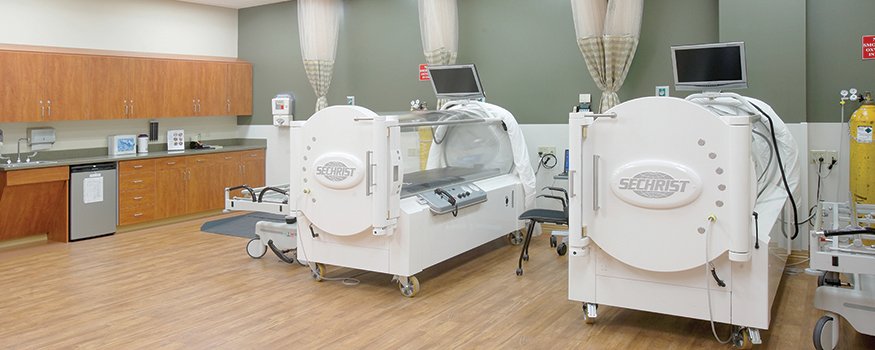Why would a patient with a wound spend almost 2 hours a day, 5 days a week, in a locked chamber receiving 100% oxygen? The answer is that medical grade hyperbaric oxygen therapy (HBOT) can be a valuable adjunct therapy for selected types of wounds.
In this article, I’ll focus on hospitals and clinics that follow guidelines from the Undersea & Hyperbaric Medical Society as I give you a brief overview of how HBOT works and its use in wound care.
How HBOT helps in wound healing
The air that we breathe is 21% oxygen. With HBOT, patients are placed in a sealed chamber, where they breathe 100% oxygen under pressure. The pure oxygen saturates blood cells and blood plasma, which in turn increases oxygen supply to the tissues—including the wound being treated. HBOT can reduce the time it takes for a wound to heal by:
• promoting collagen deposition, enhancing epithelial cell migration, and decreasing local tissue edema
• killing anaerobic bacteria in tissue and bones
• preventing additional bioburden by increasing leukocyte production and activity
• enhancing angiogenesis (development of new blood vessels), which brings more blood and healing factors to the wound. Keep in mind that although angiogenesis can be beneficial for wounds with insufficient perfusion, HBOT is not an alternative to revascularization.
Not all wounds benefit from HBOT. (See Types of wounds treated with hyperbaric oxygen therapy.)
Length of treatment
The average treatment time is 110 minutes in the HBOT chamber: about 10 minutes for a patient to reach the appropriate pressure, 90 minutes at the pressure, and 10 minutes to return the patient to normal pressure. Times can be expedited in the case of an emergency; for example, a patient can be out of the chamber in 7 minutes if he or she experiences a serious reaction. The average length of treatment is 30 visits, normally 5 days a week for 6 weeks.
A safety director monitors the HBOT chambers and treatment area, and a supervising provider is present at all times to monitor each treatment and prevent or manage emergencies.
Possible negative effects
Overall, HBOT is a safe treatment for serious wounds, but there can be negative effects. The most common of these is barotrauma—discomfort in the ear when the pressure on the outside of the ear is different than the pressure on the inside of the ear. This is similar to when you are flying in a plane or diving under water and your ears feel like they are plugged up.
Although quite rare, patients can develop a tension pneumothorax. Other important potential side effects include hypoglycemia and hypoglycemic seizures, oxygen toxicity with seizures, and vision changes that can persist for up to 6 weeks after treatment.
Some patients are claustrophobic and require sedation medicine before entering the chamber.
Timely intervention
HBOT should not be considered a last-resort wound treatment, although typically insurers require an adequate trial of other high-quality wound care interventions before granting authorization. It’s important to refer potential patients early so they can get treatment as soon as possible. Early referral can make a significant difference. For example, HBOT may help the patient avoid an amputation, which has been shown to reduce life expectancy for patients with diabetes.
A healing effect
HBOT can make a difference in wound healing and, in turn, a patient’s quality of life. Keep this option in mind and refer patients with wounds who may benefit from it for further evaluation. For more information about HBOT, visit the website for the Undersea and Hyperbaric Medical Society. Also, see Patient education resources for hyperbaric oxygen therapy.
Debra Clair is a wound care and hyperbaric therapy provider at University Hospitals Wound Care and Hyperbaric Center in Streetsboro, Ohio.
Selected references
Cakmak T, Battal B, Kara K, et al. A case of tension pneumothorax during hyperbaric oxygen therapy in an earthquake survivor with crush injury complicated by ARDS (adult respiratory distress syndrome). Undersea Hyperb Med. 2015;42(1):9-13.
Kaur S, Pawar M, Banerjee N, Garg R. Evaluation of the efficacy of hyperbaric oxygen therapy in the management of chronic nonhealing ulcer and role of periwound transcutaneous oximetry as a predictor of wound healing response: randomized prospective controlled trial. J Anaesthesiol Clin Pharmacol. 2012;28(1):70-5.
Medicare.gov. Hyperbaric oxygen (HBO) therapy. n.d.
Weaver LK, ed. Hyperbaric Oxygen Therapy Indications, 13th ed. Undersea and Hyperbaric Medical Society. 2014.
Online Resources
B. http://hyperbaricoxygentherapy.com/patient-info
135,44/
D. http://www.kentri.org/woundcare/hyperbaric-oxygen-therapyfacts.cfm







